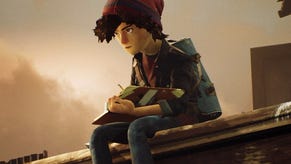PS4 exclusive Concrete Genie is a unique exploration of bullying's impact
"We hope it gives younger people a chance to share their experiences, and talk about them more easily."
Denska - a dilapidated and abandoned fishing town devastated by an environmental disaster. It's here you start your journey in Concrete Genie. You play as Ash, a young artist exploring the now dangerous area he once grew up in, lighting it up with his art while avoiding the bullies that lurk around the corner.
In case you missed it, Concrete Genie was announced at Sony's conference at Paris Games Week in 2017, and is being developed by PixelOpus, the studio behind Entwined. It's an ambitious indie game that, from my perspective, is shaping up to be another PS4 exclusive single-player gem, and it explores a theme I don't think I've seen touched on in such a creative way in a game - bullying.
After going hands on with a demo of Concrete Genie, I got a chance to have a chat with creative director Dominic Robillard and art director Jeff Sallangi who told me what inspired them to make the game.
"I think one of the most important things, and we've seen this when we've been testing the game even with adults as well, is it's great to give people a way to talk about these things," Dominic said. "We've had a chance to talk with parents and kids who've been bullied, and sometimes being able to share an experience like this with a loved one, actually talk about how you feel, and share the experience of what Ash is going through in the game is really important.
"Then to also have this very positive creative outlet you can get when you're playing a game, we hope that gives younger people a chance to play with adults as well, and share some of those experiences and talk about them more easily."
Throughout the game you'll collect a variation of brushes with different motifs. In the demo I played, there was a very natural theme, allowing me to decorate the walls of this abandoned village with arching trees and blooming flowers. The themes for what you'll get to paint are also linked to Ash and the emotions he's experiencing at different points in the narrative.
"One of the things we thought would be therapeutic is, if a kid has had a bad day they can come home and express themselves in the game, make some of these Genies and affect their personalities with how they're painted," Dominic said.
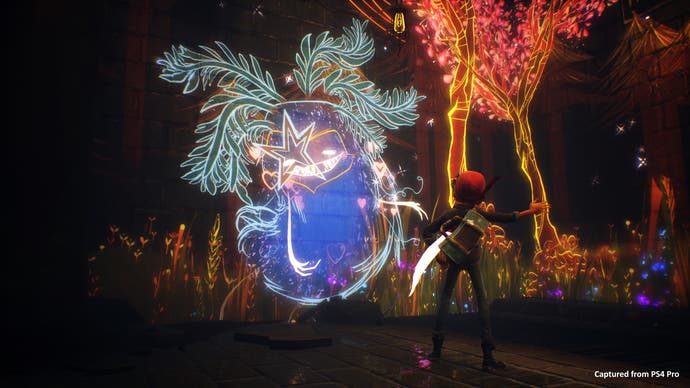
"There's a lot of expression you can get into with a lot of different sets of brushes that you find as you go through. We've tried to tailor-make those to follow the emotional contour of Ash as he's going through the story, and so as the bullying gets worse for him, the brushes you pick up reflect that mental transition as well.
"The second set of landscape brushes you get in the level after this demo are focused around thunderstorm themes, so by the time you finish the game there's a really broad set emotionally as well, not just visually. They feel very different in terms of how you paint with them."
Jeff added, "We also wanted adults to kind of remember what it was like to do finger painting for the first time or draw something in class when they were a child, and we've really put a lot of effort and time into tuning the way you create artwork in the game to be accessible for anyone, even if you're not a trained artist, and to make sure it feels like their artwork is coming alive with the controller."
The painting is done using the DualShock 4's motion controls - an aspect I found finicky at first, but after using it for a little while I gradually got the hang of it. The drawing itself doesn't require any previous artistry skills, you pretty much just select what you'd like to draw from a menu of designs that you've collected in Denska, then use the motion controls to shape it the way you'd like. This might be a bit disappointing for those who are more artistically inclined, but for everyone else it makes the game a lot more accessible.

There's more to discover and go back through after you've completed the game, too. "Once you finish the game there is a continue mode that reflects what you've done in the game up to that point," Dominic said, "and there's lots of other brushes to go and find and we've hidden some other secret hidden painting puzzles in there as well. They are there when you go through the first time, but people don't obviously find all of them when they're following the story.
"Each of the levels - we call them open neighbourhoods - they kind of build up, so you can always backtrack, and the footprint of the world grows as you play through the game."
"And we're such as small team that the whole world that you see was modelled by 2 environment artists," Jeff added. "There's a lot of care and attention to detail in that environment for sure."
These open neighbourhoods are named as such because you can traverse them however you like, and complete the puzzles in whichever order you come across them in. You'll need to use the little nooks and crannies to hide from the bullies lurking around, and even climb up to the rooftops to avoid being seen. They aren't huge open worlds like you might be used to, but more contained zones - reflective of the fact it's based on a small fishing village in China.
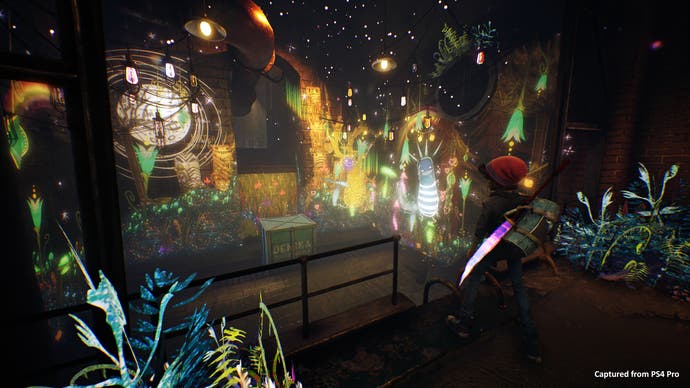
"It was really interesting when we were doing all the research in the beginning of the project, and everyone was sharing experiences from their own backgrounds," Dominic told me. "I grew up in Bristol, which has quite a well known history with urban illustration and communities sharing that rejuvenation of areas that they want to make happier and brighter. This was something I had in common with the designer, Jing Li, she had exactly the same thing in her fishing town in China.
"But they focused predominantly on kids illustrations, and so they would actually go out and have kids from the schools rejuvenate areas where she grew up with really bright, colourful illustrations. It was such an unusual thing we ended up having in common that I didn't expect, and that's where a lot of that game play and a lot of that structure for the game came from."
Along with the themes of bullying, Dominic stressed that there's also a strong environmental theme on the surface of the game too.
"That's something that came from Jing's village as well, it used to be a fishing village that's now being dwarfed by industry. The photos of where she's from are fascinating, you can see this huge industrial complex right on top of a tiny, what used to be quaint, fishing town. It's something that's almost as universal as the bullying theme in a way, and very relatable."

"There's some really alarming statistics about kids that get bullied turning into bullies themselves, it's very cyclical. One of the main messages we hope people take away from the game is that if you can break that cycle with some tolerance, empathy and understanding. There's a way to close that gap between kids that are bullying and being bullied."
Towards the end of the demo the game introduced some darker themes which involved a unique combat element. So as not to spoil anything, all I'll say is it's a very different tone to everything I had seen so far - but according to Dominic, that's exactly the point.
"We wanted to put that in to give an outlet for some of that frustration narratively that builds up at the beginning of the game. And also keep it focused on the darkness and the negatives, that emotion itself rather than the kids.
"We went back and forth on whether to reveal that, but I think it's important to know where the game goes and what the breadth of the game play is."
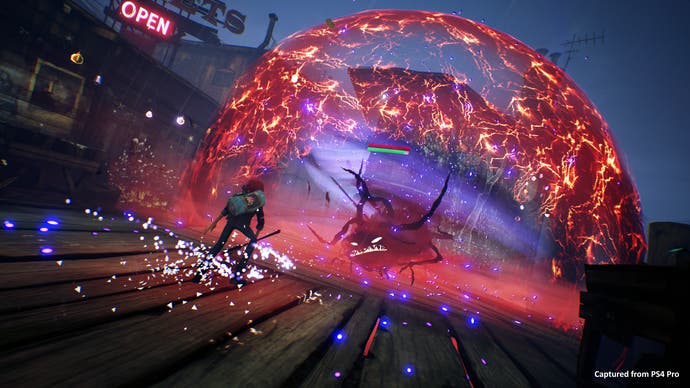
Aside from the compelling themes and interesting gameplay, Concrete Genie's facial animation really caught my eye. From the outset you can tell it's inspired by stop-motion animation, and it works really well at helping the game achieve such a unique look.
"We love stop-motion animation, and of course we're inspired by people like Tim Burton and Jim Henson, who create these incredible worlds. We tried to make our own environment that was inspired by the attention to detail and hand crafted nature of practical stop-motion," Jeff explained.
With such a visually engaging title, players will no doubt be eager to screenshot their creations. That's why Concrete Genie will include a photo mode - with a twist. This photo mode will allow you to take a time lapse of your paintings, so when you're all finished lighting up one of Denska's walls, you'll be able to watch a replay of all your vibrant masterpieces fading into existence.
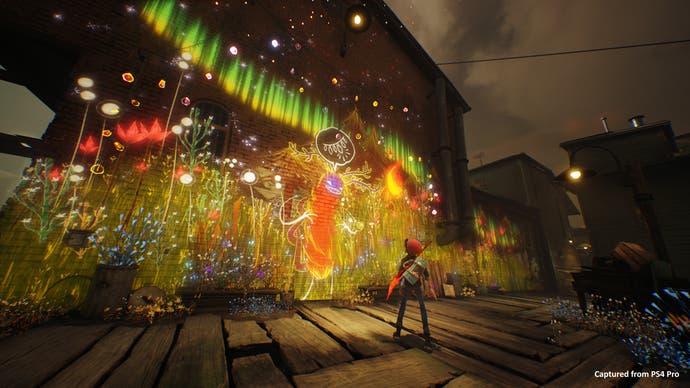
I also got to try my hand at Concrete Genie's VR mode, which Eurogamer's Ian Higton applauded for being "a beautiful and chill VR experience", but criticised when it came to the actual artistry, "which is more a case of painting pre-existing assets onto the stage, rather than a full-blown creative affair". While I felt similarly to Ian on this one, it was still a delightful experience which you get for free with the main game, so don't let that put you off from giving it a go.
You'll be able to experience Concrete Genie in all its neon glory for yourself on PS4 on the 9th October.






